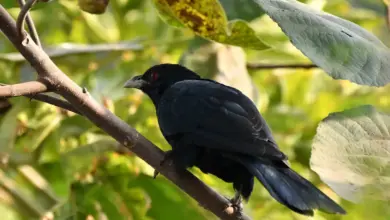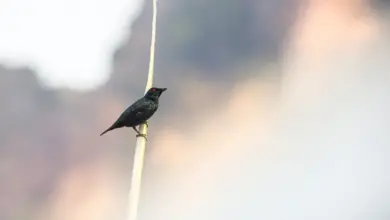Broad-tailed Hummingbirds
The Broad-tailed Hummingbird (Selasphorus platycercus) is a long-bodied, broad-tailed hummingbird that occurs mostly in the western United States and Mexico.
It has been named for the broad, rounded tail of both males and females.
The average lifespan of hummingbirds is 3 to 4 years.
The longest recorded life span for any hummingbird in North America is from a female Broad-tailed that was tagged then recaptured 12 years later, making her at least 12 years old.
Distribution / Range
The Broad-tailed Hummingbird is mostly a migratory species with some resident populations in Mexico.
They summer throughout much of the inland West of the United States and Mexico, and the northern populations travel south to winter in Mexico.
In the United States, they have been observed in Alabama, Arizona, Arkansas, California, Colorado, Delaware, Florida, Georgia, Idaho, Kansas, Louisiana, Mississippi, Missouri, Montana, Nebraska, Nevada, New Mexico, North Carolina, Oregon, South Dakota, Texas, Utah and Wyoming.
They are also found in Manitoba, Canada.
Breeding
Migratory populations breed across mountain forests and meadows throughout the Western United States from eastern California and northern Wyoming south through Great Basin and Rocky Mountain states to southern Arizona and western Texas.
The tropical resident populations are found in the cordilleran mountain areas of northern Mexico ranging as far south as northern Guatemala.
Migratory populations breed in Colorado and Wyoming, while tropical resident populations breed in central Mexico.
Winter
The northerly birds migrate south to overwinter in the southern part of their range, which is upland Mexico to the highlands of Guatemala.
The wintering birds are somewhat vagrant are regularly seen in El Salvador where it doesn’t breed.
Habitat
In the tropical parts of their range, they typically occur at high elevations – ranging from 700–900 m (2,300–3,000 ft) up to 3,350 m (10,990 ft).
Their preferred habitat includes mountain meadows mountain clearings, pinyon-juniper woodlands, dry ponderosa pines, fir or mixed forests, and canyon vegetation.
In winter, they may spend some time in coastal areas. They are also known to visit gardens inland.

Status
These small birds are fairly common and are not considered endangered. They have adapted well to human-modified habitats and even greatly benefitted from it.
Diet / Feeding
The Broad-tailed Hummingbirds primarily feed on nectar taken from a variety of brightly colored, scented small flowers of trees, herbs, shrubs, and epiphytes. They favor flowers with the highest sugar content (often red-colored and tubular-shaped) and seek out, and aggressively protect, those areas containing flowers with high-energy nectar.
They use their long, extendible, straw-like tongues to retrieve the nectar while hovering with their tails cocked upward as they are licking at the nectar up to 13 times per second. Sometimes they may be seen hanging on the flower while feeding.
Many native and cultivated plants on whose flowers these birds feed heavily rely on them for pollination. The mostly tubular-shaped flowers actually exclude most bees and butterflies from feeding on them and, subsequently, from pollinating the plants.
In winter, when flowering plants may not be readily available, they may drink the sap from holes created by sapsuckers, as a substitute for nectar. They may also visit local garden feeders for some sugar water, or drink out of bird baths or water fountains where they will either hover and sip water as it runs over the edge; or they will perch on the edge and drink – like all the other birds; however, they only remain still for a short moment.
They also take some small spiders and insects – important sources of protein particularly needed during the breeding season to ensure the proper development of their young. Insects are often caught in flight (hawking); snatched off leaves or branches, or taken from spider webs. A nesting female can capture up to 2,000 insects a day.
Males establish feeding territories, where they aggressively chase away other males as well as large insects – such as bumblebees and hawk moths – that want to feed in their territory. They use aerial flights and intimidating displays to defend their territories.
Breeding / Nesting
Hummingbirds are solitary in all aspects of life other than breeding, and the male’s only involvement in the reproductive process is the actual mating with the female. They neither live nor migrate in flocks, and there is no pair bond for this species.
Males court females by flying in a U-shaped pattern in front of them. He will separate from the female immediately after copulation. One male may mate with several females. In all likelihood, the female will also mate with several males. The males do not participate in choosing the nest location, building the nest or raising the chicks.
The female is responsible for building the small cup-shaped nest out of plant fibers woven together and green moss on the outside for camouflage in a protected location in a shrub, bush or tree.
She usually nests in the same tree or bush year after year. She will either build a nest on the same branch or even build a new nest atop the old one.
She lines the nest with soft plant fibers, animal hair, and feathers down, and strengthens the structure with spider webbing and other sticky material, giving it an elastic quality to allow it to stretch to double its size as the chicks grow and need more room. The nest is typically found on a low, thin horizontal branch.
The average clutch consists of two white eggs, which she incubates alone for about 16 days, while the male defends his territory and the flowers he feeds on. The young are born blind, immobile, and without any down.
The female alone protects and feeds the chicks with regurgitated food (mostly partially digested insects since nectar is an insufficient source of protein for the growing chicks). The female pushes the food down the chicks’ throats with her long bill directly into their stomachs.
As is the case with other hummingbird species, the chicks are brooded only the first week or two and left alone even on cooler nights after about 12 days – probably due to the small nest size. The chicks leave the nest when they are about 23 days old.
This species is known to hybridize with Costa’s Hummingbird, but apparently only very rarely.
Calls / Vocalizations / Sounds
Their calls are described as a repeated chitter, chitter, chitter or a sharp click.
Alternate (Global) Names
Spanish: Chispita de Cola Ancha, Colibrí Coliancho, us zumbador cola ancha, Zumbador Cola Ancha, Zumbador Coliancho … Italian: Colibrì codalarga … German: Breitschwanzelfe, Dreifarbenkolibri, Dreifarben-Kolibri … Latin: Selasphorus platycercus, Trochilus platycercus … Czech: kolib?ík šestibarvý, Kolibrík tríbarvý … Danish: Bredhalet Dværgkolibri … Finnish: Vinkukolibri … French: Colibri à large queue, Colibri à queue large, Colibri tricolore … Japanese: futoohachidori … Dutch: Breedstaartkolibrie … Norwegian: Bredhalekolibri … Polish: rudaczek szerokosterny … Russian: ??????????? ?????????? … Slovak: cmelovec širokochvostý, Kolibrík širokochvostý … Swedish: Bredstjärtad kolibri





